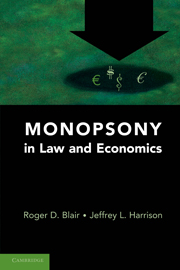Book contents
- Frontmatter
- Contents
- Preface
- ONE Introduction
- TWO The Antitrust Laws and Monopsonistic Forms of Conduct
- THREE Economic Theory of Monopsony
- FOUR The Antitrust Response to Monopsony and Collusive Monopsony
- FIVE Cooperative Buying Efforts
- SIX Bilateral Monopoly
- SEVEN Monopsony and Antitrust Enforcement
- EIGHT Monopsony in Action: Agricultural Markets
- NINE Monopsony in Action: The NCAA
- TEN Monopsony in Action: Physician Collective Bargaining: Monopoly or Bilateral Monopoly
- ELEVEN Final Comments
- Bibliography
- Index
NINE - Monopsony in Action: The NCAA
Published online by Cambridge University Press: 05 June 2012
- Frontmatter
- Contents
- Preface
- ONE Introduction
- TWO The Antitrust Laws and Monopsonistic Forms of Conduct
- THREE Economic Theory of Monopsony
- FOUR The Antitrust Response to Monopsony and Collusive Monopsony
- FIVE Cooperative Buying Efforts
- SIX Bilateral Monopoly
- SEVEN Monopsony and Antitrust Enforcement
- EIGHT Monopsony in Action: Agricultural Markets
- NINE Monopsony in Action: The NCAA
- TEN Monopsony in Action: Physician Collective Bargaining: Monopoly or Bilateral Monopoly
- ELEVEN Final Comments
- Bibliography
- Index
Summary
Introduction
As noted in Chapter 1, one of the more prominent areas in which monopsony issues arise is in the market for athletes. Professional leagues, such as the National Football League and the National Basketball Association, use reverse order drafts to avoid competing among teams for entry-level players. The teams have agreed on eligibility requirements, free agency, and other terms of employment. Our focus here is not on professional athletes but on amateur athletes “employed” by various colleges and universities. As we will see, they operate under the auspices of the NCAA in monopsonistic ways.
Introduction to the NCAA
The NCAA has been characterized as a cartel, that is, “a combination of independent commercial or industrial enterprises designed to limit competition.” This is unfair since one might object that the NCAA’s members are institutions of higher learning rather than “commercial or industrial enterprises.” But this objection is misplaced. As we will see, this is an accurate characterization, especially as it relates to the labor market for student-athletes and coaches. More precisely, the NCAA acts as a buyer cartel or a collusive monopsony. Under the auspices of the NCAA, the member institutions collude to reduce competition among themselves in an effort to reduce costs and thereby generate more “profit” for their athletic programs. Examples of collusive monopsony can be found throughout the economy, but the NCAA is a particularly good example.
- Type
- Chapter
- Information
- Monopsony in Law and Economics , pp. 188 - 204Publisher: Cambridge University PressPrint publication year: 2010



